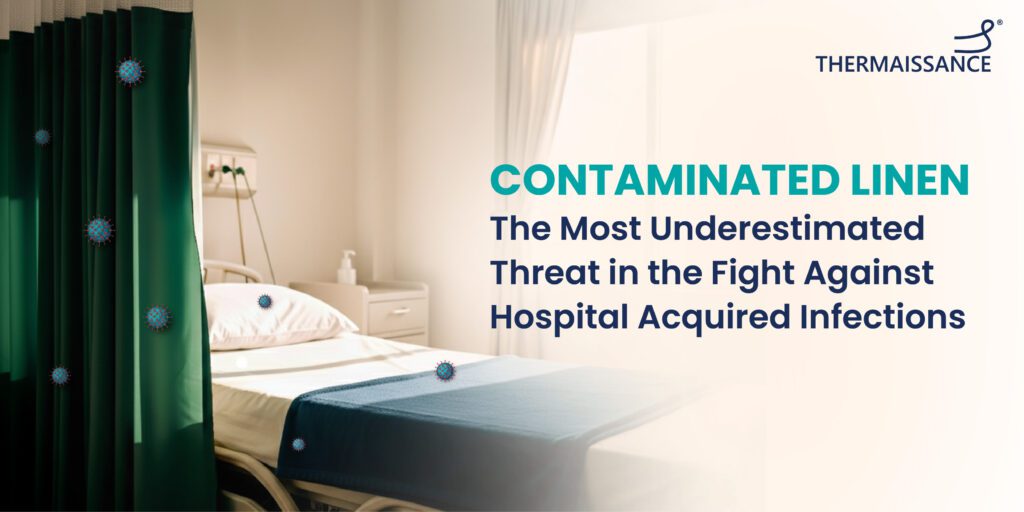
Hospitals follow strict regulatory protocols to prevent hospital-acquired infections (HAIs). According to the WHO, the prevalence of hospital-acquired infections is estimated to be 7.6% in developed countries and 5.7 — 19.1% in developing countries1. While attention is given to hand hygiene and sterilization of medical instruments for infection control, the sterilization process of hospital linens can be compromised due to human error, equipment malfunction, or inadequate protocols2. Fabrics like privacy curtains, bed linens, patient gown, doctor scrubs, etc, can silently harbour millions of harmful pathogens facilitating the spread of infections between patients2.
How are textiles a hidden link to hospital-acquired infections?
Hospital linens regularly come in direct contact with patients and their wounds or body fluids. As pathogens thrive on such surfaces, hospital linens automatically serve as reservoirs for harmful pathogens posing a threat to patient safety. Pathogens, including multi-drug-resistant organisms (MDROs) such as methicillin-resistant Staphylococcus aureus (MRSA), Clostridium difficile, vancomycin-resistant enterococci (VRE), Acinetobacter baumannii, and Pseudomonas aeruginosa are known to survive for hours or days on these soft surfaces3.
What makes this issue particularly more concerning is that freshly laundered linens often appear clean to the naked eye but, microorganisms can still survive even after following standard laundering protocols.2
According to the PGIMER study published in the Journal of Patient Study and Infection Control, 57% linens were found to be contaminated even after laundering4.
Therefore, this gap demands an increased need for rigorous infection control of the hospital textiles, especially in ICU’s where patients are more vulnerable.
Smarter textile solutions: The way forward
The solution lies in adopting antimicrobial hospital textiles that actively prevent microbial growth between washes. Advanced fabrics like those developed by Thermaissance are engineered with antimicrobial technology. Thermaissance textiles provide comprehensive defense against bacteria, fungi, and viruses through three mechanisms:
Bacteriostatic and Bactericidal Action prevents bacterial growth by disrupting reproduction and metabolic processes.
Fungistatic and Fungicidal Action by disrupting cellular structures, thereby inhibiting fungal growth
Virustatic and Virucidal Action where viral replication is blocked by binding to viral particles and preventing cell attachment, leading to zero viral load.
Such innovations not only enhance hygiene, but also help reduce laundry load, extend fabric life, and promote safety for healthcare workers and patients.
Conclusion
Hospital linens may seem harmless, but they are often a hidden contributor to nosocomial infections. As healthcare systems strengthen their infection control measures, it’s time to recognize the need to prevent HAIs from healthcare textiles.
References:
- Owen L, Laird K. The role of textiles as fomites in the healthcare environment: a review of the infection control risk. PeerJ. 2020 Aug 25;8:e9790. doi: 10.7717/peerj.9790. PMID: 32904371; PMCID: PMC7453921.
- Fijan S, Turk SŠ. Hospital textiles, are they a possible vehicle for healthcare-associated infections? Int J Environ Res Public Health. 2012 Sep 14;9(9):3330-43. doi: 10.3390/ijerph9093330. PMID: 23202690; PMCID: PMC3499872.
- Role of healthcare apparel and other healthcare textiles in the transmission of pathogens: a review of the literature. Mitchell, A. et al. Journal of Hospital Infection, Volume 90, Issue 4, 285 – 292
Sharma, Raman; Krishnamoorthi, Sivanantham1,2; Kumar, Ashok; Biswal, Manisha1; Koushal, Vipin. Bacterial counts of hospital linen and effectiveness of laundry process: A need for consensus on microbial sterility of hospital linen. Journal of Patient Safety and Infection Control 10(1):p 6-9, Jan–Apr 2022. | DOI: 10.4103/jpsic.jpsic_1_22
Recent Posts
-
30 Oct 2025 ThermaissanceDefeating Neonatal Hypothermia: How the Thermaissance Baby Hugg Revolutionizes Thermal Management for Preterm Infants
-
28 Oct 2025 ThermaissanceWhy Contaminated Linen is the Most Underestimated Threat in the Fight Against Hospital Acquired Infections
-
09 Aug 2022 ThermaissanceWhy UV Protective Clothing is a Must
